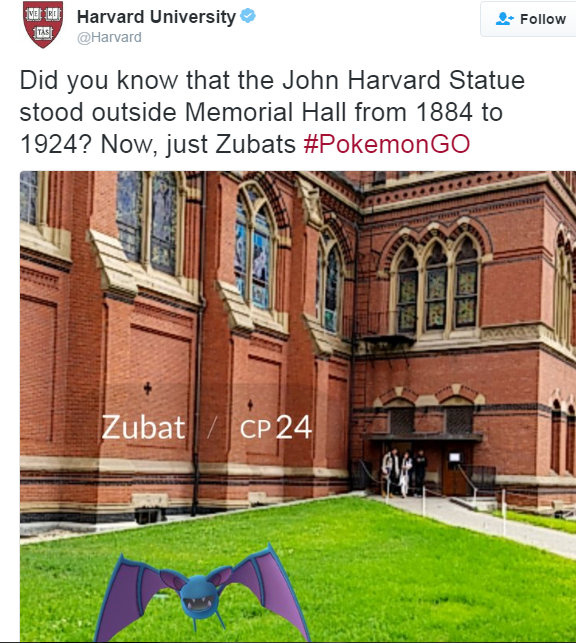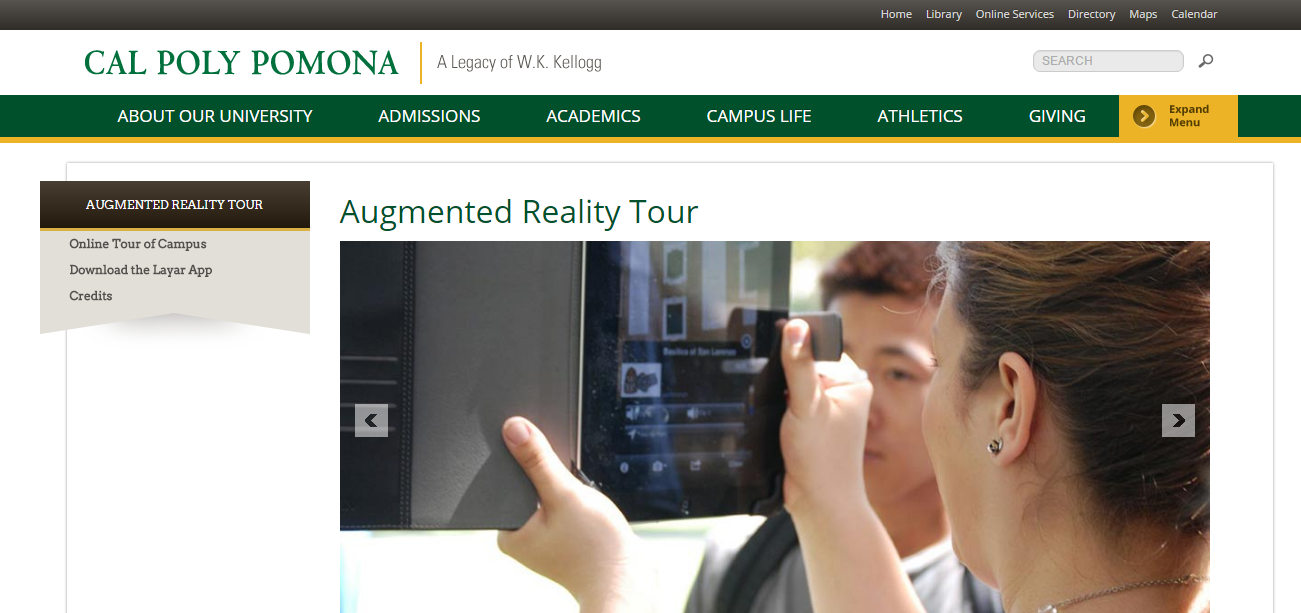
Love it or hate it, there’s been no escaping the Pokemon Go craze over the last few months. The augmented reality app based on the popular anime franchise has taken the world by storm since its release in June, with 100 million downloads on Google Play alone by early August, the same amount of daily users as Twitter, and a higher average daily usage time than Whatsapp, Snapchat, Instagram, and Messenger.
While only time will tell if the app can maintain its momentum, its popularity among younger age groups has forced recruiters to sit up and take notice of the trend, with some even finding ways of incorporating the phenomenon into their promotional activities.
Even more intriguingly, its success has taken augmented reality technology mainstream, opening up a number of exciting possibilities for schools to discover new, fun, and innovative ways to engage with the online community.
In this blog, we not only explore the marketing potential of Pokemon Go, but also augmented reality as a whole, demonstrating the enormous potential of the technology to enhance your student recruitment campaigns in ways you never thought possible.
How Does Augmented Reality Work? A Guide for Recruiters
Augmented reality (AR) technology allows you to view superimposed digital content in a real-life environment through a digital device. AR applications work by creating markers for specific locations and objects, when can then be overlaid with sound, images, visuals and 3D graphics, and unlocked by anyone using that specific AR application.
Whereas virtual reality creates a completely artificial environment, AR places content within the real world in real time. This offers a number of potential advantages for marketers, allowing them to connect with people anywhere as they go about their daily lives, increasing their ability to attract and engage with their targeted audience.
Read on for five innovative ways schools around the world are already using augmented reality to connect with potential recruits.
1. How Schools Are Using Pokemon GO To Catch Prospective Students Online
Pokemon GO uses mobile GPS to allow users to locate and capture virtual creatures, which appear on their screens in real world locations through the use of AR technology. This aspect of the game makes it unique from most popular phone apps, as it encourages users to get outside and explore their surroundings, offering further incentives by placing special ‘gyms’ and ‘pokestops’- locations where users can battle or load up on in-game rewards- at various landmarks.
Even in its brief lifetime, the app has already attracted a number of forward-thinking schools eager to use it to connect with both current and prospective students, most noticeably on social media. The augmented reality setting makes it perfect for promoting your campus, as recruiters can easily take screenshots of Pokemon in the game next to well-known landmarks, sharing them on platforms like Instagram, Snapchat, and Twitter and encouraging students to do the same.
Example: Harvard University are among the many schools who have shared images from the game outside well-known campus landmarks, like this one near Memorial Hall.

Other universities have been even more proactive in finding clever ways to use the game to gain exposure, with many actively promoting the gyms and pokestops on their campus via social media sites and their own websites.
Example: Duke University even shared a special map of their campus for Pokemon GO users:

You’ll notice that the university is also promoting its own specific hashtag for the game to encourage social sharing. Not only that, but Duke even went as far as placing lures- in-game purchases that draw Pokemon to a specific location- outside their admissions office for any visiting prospects, and even incorporated it into their email lead nurturing campaigns, sending out a mail blast encouraging potential recruits to visit the pokestops on their campus, including their lemur sanctuary, which also featured heavily in their social media activities.

With the app still in its infancy, recruiters have only begun exploring its potential to generate more student enquiries, and may find even more useful ways to use it in future. One area in which many experts are predicting it could take off in a big way is themed campus tours, which allow prospective students to be shown around facilities while they enjoy the game.
Example: Washington State University Tri-Cities is already offering student-led tours of its grounds:

Pokemon GO developers Niantic have also started implementing sponsored locations into the game, beginning in Japan, where all McDonald’s restaurants are now a pokestop or a gym. The sponsored locations will be available on a ‘cost per visit’ basis- similar to PPC ads- and could provide another interesting avenue for recruiters.
2. Using Augmented Reality to Transform Your Campus Tours
While offering Pokemon GO themed campus tours is a fun and interesting idea, it’s just one of the possibilities augmented reality offers to enhance the way you show prospective students around your campus.
In fact, a number of forward-thinking universities had already begun offering augmented reality elements in their campus tour experience long before Pokemon GO took off. Using AR technology, recruiters can place augmented reality triggers around their campus, overlaying various multimedia elements that offer visitors information about different faculties and programs, support services, and unique insights into the history of the campus.
Example: This AR tour was recently designed by students at the University of Florida. Available as an app known as UDiscover, the tour incorporates historic video footage, images, sound, and text to offer users a unique perspective of the campus.

Schools looking to develop their own tours will also find a number of AR platforms available from third party developers, such as Layar, a versatile program that offers a range of different features. AR platforms tend to be very customisable, and schools that have made use of the technology have found a number of creative ways to put their own stamp on it, and convey elements of their unique identity and history to prospective students.
Example: Cal Poly Pomona’s Layar tour features a number of fun, quirky insights into the history of the campus, showing visitors the former site of the school’s ice cream shop at the Bronco student center, and even telling the story of a 1969 fraternity initiation prank in which students attempted to steal a pig when users visit the school’s swine unit!

Even as prospective students do more and more research online when choosing schools, the campus tour remains hugely influential in their decision making process. After all, it’s their first chance to see your school in the flesh, and for many, the point at which they begin visualising themselves as a student there. Giving them a truly memorable experience like this could dramatically increase your chances of becoming their first choice institution.
3. Bringing Your School to Life with Immersive Experiences
As AR technology continues to develop, the capabilities it offers become even more exciting. Recruiters may soon have the option to go beyond simple campus tours and employ the technology to create larger events and immersive experiences that utilise complex customised functions, incorporating elements like gamificaiton and role playing.
Example: One of the most ambitious uses of AR technology by universities so far has come from the University of Wisconsin-Madison, who used an open source AR development platform known as ARIS to create a situated documentary for prospective students visiting the campus known as ‘Dow Day’. The user was given the role of a news reporter asked to cover a historic protest that took place at the university in 1967 against the Dow Chemical Company.

After downloading the app, prospective students are directed to various locations on campus that were significant to the protest and interact with various characters, asking them questions to learn more about the event.
You can see a demonstration of how ‘Dow Day’ works here:

With this kind of technology, your school could create any number of immersive experiences for prospective recruits, perhaps bringing significant moments from your own campus’s unique history to life, building AR activities around current events, or anything else you might feel will help you engage and connect with potential leads more effectively. As AR continues to advance, the possibilities are seemingly endless.
4. Add Another Level of Engagement with Recruits to Your Print Advertising Campaigns
One intriguing facet of augmented reality is that it offers the potential to bring together your online student recruitment initiatives with your more traditional print campaigns in a way that has never really been possible before. Because AR uses real world objects or locations as triggers to display content on digital devices, everything from billboards to newspaper ads suddenly have potential for more engagement.
Example: Simpson College married AR technology to prints ads very effectively in 2013 with a banner they placed in a popular mall in Des Moines, Iowa. By downloading an app and following the instructions, shoppers were able to view a special thirty second promotional video which brings the banner to life with various impressive graphics.
You can see the campaign in action, as well as the public reaction here:

Incredibly, the cost of an ad like this isn’t much more than a traditional print advertisement. The school used a free version of Hewlett Packard’s Aurasma platform, which allows users to create their own AR content to be viewed through the app. As Simpson College’s Digital Content Specialist Greg Votava explained to collegewebeditor, “Really the only cost of this project, other than my time, was the cost of the banner hanging at the mall and a secondary sign that explains how to download the app and make our banner come to life.”
Not only is the technology relatively cost-effective, but it also offers far more direct opportunities for engagement that traditional print advertising. Because the AR content is digital, marketers are able to add elements such as linked keywords and targeted calls-to-action, increasing their chances of converting potential leads.
AR also offers greater potential for measurability than has ever been possible from ordinary print campaigns, allowing recruiters to track views and conversions. The Simpson College banner, for example, included a CTA, which the institution could add a campaign tag to in order to track its success. Aurasma has since introduced its own comprehensive analytics dashboard for paid customers, which tracks views, interactions, and conversions.
5. Bring AR Technology to Prospective Students Around The World in Your Print Promotional Materials
Advertisements aren’t the only area of your print campaigns where you can incorporate AR. Institutions around the world are already using the technology in a wide range of printed promotional materials, including admissions viewbooks, prospectuses, and brochures. Developing AR for these kinds of documents means you can bring the technology to prospective recruits by mail, at recruitment fairs, or just simply make it available instantly to anyone who walks into your admissions office.
Example: The University of Waterloo are among a number of universities who have developed AR functionality for their promotional materials. Their admissions viewbook uses Layar, the same platform Cal Poly Pomona employ for their campus tours, to allow prospective students to view additional photos, text, and even video testimonials from current undergraduates, adding an extra personalised touch to the experience.
The back cover also features a number of CTAs which allow users to go straight to the university website after they have finished reading, which enables the admissions department to track conversions.
Check out the viewbook here:

As you can see, augmented reality has already been used by a number of schools to bring new dimensions to their education lead generation initiatives. As the success of Pokemon GO brings the possibilities of the technology to the attention of the wider public, incorporating AR features into recruitment campaigns is only going to become more common.
As a result, schools wishing to develop their own AR offerings will want to ensure they stand out from the crowd by creating original, quality content and experiences that communicate their unique institutional identity, keeping track of the latest advances in AR functionality, and applying some inbound marketing best practices to any AR ventures in order to maximise the potential for increased engagement and conversion.
Fortunately, there are a number of affordable, easy-to-use options available for schools looking to get involved, and the trailblazing campaigns of some of the institutions mentioned in this blog should give you plenty of ideas to get started. Have fun!
Have you used augmented reality tech in your recruitment campaigns? Has your school hopped on the Pokemon GO bandwagon? Join the conversation in the comment section below and tell us about your experiences!






